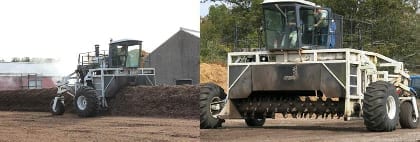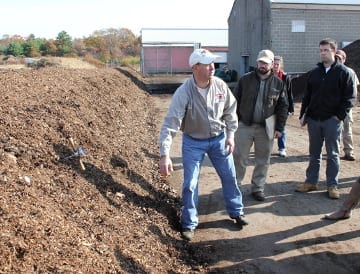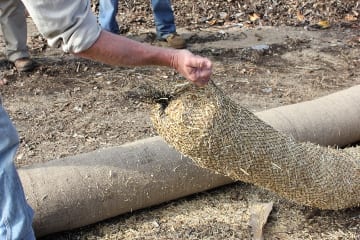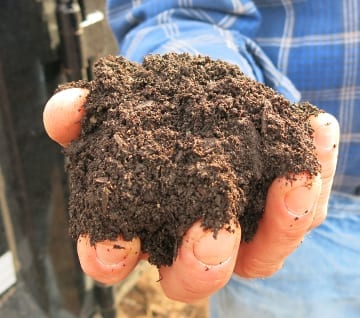by Tara Mitchell
John Engwer, owner of Groundscapes Express, and Butch Goodwin, Operations Manager, led Ecological Landscaping Alliance participants on a tour of Groundscapes’ composting facility in Wrentham, MA explaining how compost is made and discussing the many benefits and uses of compost in the landscape. Through knowledge, training, and most importantly, years of experience and trial and error, John and Butch have developed a fine-tuned operation for turning waste into a valuable product.
The Benefits of Compost
Most people are familiar with the benefits of compost as a soil amendment to improve soil quality and provide the slow release of nutrients for plants and lawns. However, compost has many other less-recognized uses and benefits in the landscape. Due to a high percentage of organic matter, compost has a large water holding capacity. When applied over bare soil as a compost-mulch mix, it has the ability to capture and hold rainwater, preventing runoff and protecting soil from erosion. For instance, a two-inch layer of a compost and wood chip mix, such as Groundscapes’s EarthBlanket, can hold approximately 160 gallons of water per 1000 square feet. Also, compost has a high number of micro-organisms which play an essential role in making nutrients available to plants and in breaking down and binding pollutants and heavy metals. All of these benefits make compost invaluable not only for gardens and lawns but also for protecting water quality and managing water in the landscape.
Composting and use of composed material essentially imitate the natural process of growth, death, decomposition, and renewal. Composting, whether as a backyard operation or a larger-scale operation, such as that at Groundscapes Express, is basically a mechanism of accelerating decomposition using manual or mechanical methods. Applying a compost-mulch mix over bare soil instantly provides the soil protection that groundcovers or leaf litter naturally provide. Compost as a soil amendment speeds up landscape restoration by providing an immediate source of organic matter, moisture and microbial activity that would otherwise take years to evolve through the natural cycles of growth and decay, but that are necessary for plant growth.
The Composting Process
Groundscapes Express’s compost begins with organic waste product brought in by local suppliers. Piles of wood chips, leaves, manure, and cranberry waste line the edges of the composting area. Turning those materials, referred to as feedstock, into a final high quality product first requires getting the recipe right: mixing the right proportions of feedstock to get the proper carbon to nitrogen ratio and to maintain the right moisture levels.
With the recent implementation of Massachusetts’s ban on food waste going into landfills, food waste from hospitals, restaurants and supermarkets will become another ingredient in the composting process. Food waste from a local hospital is already incorporated into Groundscapes’s composting process. Food waste has the benefit of higher moisture and nitrogen, but requires additional quantities of the drier feedstocks, which are higher in carbon, to get the proper carbon to nitrogen ratio and the right balance of moisture. Food waste also adds the problem of attracting wildlife and is more likely to come in with plastic debris that must be removed.
Once the right proportions of the feedstock are mixed by a loader, the material is laid out in long rows, like loaves of bread, awaiting the work of bacteria, fungi, and other living organisms to turn the material into compost. Maintaining the right balance of water and oxygen as the material decomposes is critical to creating a high-end product. Too little water or oxygen can slow decomposition. If the material is too wet, it results in anaerobic conditions, and the living organisms necessary for aerobic decomposition die. Piling the rows too high can also result in anaerobic conditions because the high moisture content of organic matter makes it heavy and susceptible to compaction within the pile. An easy way to identify poor quality compost or anaerobic compost is by smell. Bad smelling compost, or compost that smells like ammonia, is likely anaerobic and should not be used.

A compost turner is used to aerate and break down the materials to speed up decomposition. Heat and moisture resulting from the process of decomposition are released as steam.
Maintaining Optimum Conditions
During the decomposition process, air circulation is important not only to provide oxygen to the microbes but also to help maintain proper temperatures. As the bacteria and other organism feed on the carbon, energy (heat) is released. Temperatures inside the pile can reach over 200 degrees. However, for quality compost, the temperature must be maintained at an average of 140 degrees. High temperatures are necessary to kill pathogenic bacteria and organisms and to ensure that weed seeds are no longer viable. If temperatures are too high or too low, certain necessary bacteria and micro-organisms will die, altering the process and resulting in a final product that has less microbial benefit.

Butch checks the core temperature of the pile. Maintaining proper temperatures is essential for a good quality final product.
Butch and his crew take the temperature of the compost twice a week to monitor both the interior and the exterior temperature of the piles to determine when they are ready to be turned. To turn the piles, Groundscapes uses a compost turner. The tines both aerate the compost and physically break down the material, speeding up the process of decomposition. They also help sift out large chunks of wood, rocks and other debris. To ensure that material at the bottom of the pile gets aerated, the entire row is moved and shifted. From start to finish, the piles shrink by 40% as material is broken down and moisture released. As existing piles shrink and more space opens up, new piles are added.
Consistency is an essential part of the process and begins with having regular suppliers with consistent feedstock. Materials can vary, depending on the source and how much undesirable debris comes with the product. Leaf matter can vary depending on the season, and various materials have differing amounts of moisture. For instance, leaves delivered in the spring tend to be wetter and to contain more debris. Maintaining the routine of monitoring and turning is also important. Like making bread, which is also dependent on the work of living organisms, producing high quality compost is based on following the rights steps: using the right proportions of ingredients, proper handling of material, and paying attention to temperature and timing.
The material takes about four months to decompose and is then left to cure for another two months. It is then screened to remove larger material and any debris. The finished product, dark brown, moist, light and crumbly, smelling of earth and full of microbes, is finally ready to be delivered for use in the landscape.
Compost Filter Tubes
In addition to using and supplying compost for application to soils, John invented compost filter tubes for use as erosion control. Using a compost blower truck, a mix of two parts wood mulch and one part compost is blown into burlap tubes on site. Due to the weight of the compost mix (approximately 30 pounds a cubic foot dry and 90 pounds wet), the tubes, unlike haybales and siltfence, do not need to be trenched in, avoiding disturbance that leaves the soil and the site susceptible to weed seeds. The tubes can also be easily placed on compacted or frozen soils.

John demonstrates the weight difference between his compost-blended FilterMitt and a straw wattle used for erosion control. The weight of the compost-blended tubes allows them to withstand heavy, rapid flows. The straw wattles are more appropriate for flat surfaces and lower flow rates.
These burlap tubes filled with compost and wood chip mulch provide multiple benefits for stormwater management. They physically filter sediment and serve as a physical barrier, slowing the velocity of water. Due to its water holding capacity, the compost captures and holds water, reducing flow. The micro-organisms provide additional long-term benefit by chemically breaking down, binding and reducing nutrients and pollutants, such as heavy metals, petroleum products, and harmful bacteria, thus protecting water quality. And, because the burlap is biodegradable, the tubes do not have to be removed and continue to provide a benefit as they decompose in place.
All the Earth Is a Rain Garden
As the tour ended, John noted, “All the earth is a rain garden.” The entire landscape works as a system, absorbing, infiltrating, releasing, cleaning, and cycling water. Like the composting process, that system is dependent on a continual supply of organic matter. John emphasized the importance of using, re-using, and retaining existing wood, stumps, brush or other natural material on site so that organic matter can remain part of the cycle of growth, death, decomposition, and renewal. Composting and returning organic matter back to the earth at any stage of decay is to partake in preserving, restoring, and maintaining this vital cycle of life.
About the Author
Tara Mitchell is a landscape architect with Massachusetts Department of Transportation. Her responsibilities include design, design review, and construction services for landscape restoration. Tara may be reached at tara.mitchell@state.ma.us.



